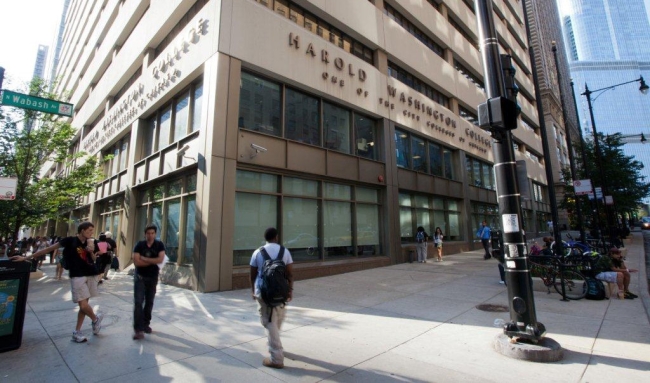You have /5 articles left.
Sign up for a free account or log in.

Harold Washington College, one of seven City Colleges of Chicago
Flickr
An unusual free college proposal has emerged from the crowded and contentious race for mayor in Chicago.
Bill Daley, one of 14 mayoral candidates vying to lead the country’s third-largest city, wants to merge Chicago's public school system with the city's two-year college system to allow public high school graduates to continue on to community college for free.
By combining Chicago Public Schools, or CPS, and City Colleges of Chicago, or CCC, Daley's so-called K-14 plan would ostensibly help students attend college without accumulating debt from tuition and fees.
A merger between the two systems would be a massive undertaking and create the first prekindergarten through community college system in the nation. CPS has more than 361,000 students, 36,400 employees and a nearly $6 billion budget. City Colleges is the largest two-year system in Illinois. It has a $436 million budget and more than 80,000 students and 4,000 faculty and employees across seven colleges.
“To keep Chicago strong and growing, we need to rethink our public education system to get more young people the skills they need to succeed at a price they can afford,” Daley said in a news release.
Daley, the son and brother of two former Chicago mayors, said two studies helped him and his policy team come up with the idea. One is a report from the Georgetown University Center on Education and the Workforce that says two-thirds of new jobs today require some college education. The second report, also from Georgetown, says there are 30 million jobs that don’t require a four-year degree.
The idea was also driven by the low academic performance in college by Chicago students, said Peter Cunningham, communications director for Daley’s campaign. The University of Chicago Consortium on School Research estimates that only 19 percent of CPS students who were freshmen in 2017 will earn a four-year degree within 10 years. And the three-year graduation rate for students attending City Colleges institutions was just 22.9 percent in 2018, although that number has been disputed by faculty who believe it is lower.
“We know that cost can be a barrier for many people even though tuition is low in Chicago City Colleges,” Cunningham said. “We basically decided to remove the barriers and make City Colleges enrollment free and automatic for all CPS grads who want it.”
Tuition for city residents is $146 per credit hour, or $1,752 for 12 credits or more.
Many CPS graduates choose to enroll at four-year colleges; 47 percent attend a four-year institution immediately after high school and 20 percent enroll at a two-year college, according to the consortium. Another 20 percent of CPS graduates delay attending college, although they eventually enroll in a two-year college.
The Daley campaign believes the merger would also save the city an estimated $50 million, which would then fund the free college program. About 20,000 students graduated from city public schools in 2016, and 3,600 of them enrolled in City Colleges institutions. Daley’s proposal would expand Chicago’s Star Scholarship program, which covers tuition for CPS graduates who had at least a 3.0 grade point average and don't need remedial math or English in college.
Daley is the only mayoral candidate who has proposed and supports such a merger. None of his opponents have supported the idea.
Gery Chico, a former school board president and City Colleges chairman also running for mayor, told The Chicago Sun-Times that a merger to save $50 million isn't “worth the monumental effort it would take to accomplish.”
Daley’s proposal would still require adult learners and students who didn’t graduate from CPS to pay tuition at City Colleges institutions.
CPS administrators did not respond to requests for comment on the potential merger. City Colleges officials declined to comment.
The Chicago Teachers Union, which endorsed candidate Toni Preckwinkle in the mayor’s race, said in a statement that Daley’s merger plan was “one of the more ridiculous ideas we’ve heard in recent memory.”
The teachers’ union said Daley's plan would be a failed experiment that would cut already strained school budgets and lead to school closings.
"His plan to combine Chicago Public Schools and the City Colleges of Chicago is the kind of tone-deaf proposal you hear at thousand-dollar-a-plate dinners frequented by the donors supporting his campaign and would add multiple layers of bureaucracy to two systems already struggling under their own weight," the union statement said.
City Colleges faculty also are against any proposed merger with CPS. The faculty members are preparing for a possible strike as contract negotiations have stalled between the union and the college system's administration.
“Daley’s proposal to merge City Colleges with Chicago Public Schools is misguided at best and is reckless and damaging at worst,” Tony Johnston, president of the Cook County College Teachers Union, said in an email. “It is not clear at all what the reasoning is behind this proposal, except to eliminate positions of CPS or CCC employees.”
He noted that state education laws governing and funding the community colleges and the school district would have to be changed, and both large systems would have to hammer out an intergovernmental agreement.
“The legal and political steps to merge these two systems would make the effort a waste of time and resources,” he said.
Johnston said making community college free is the one positive aspect of Daley’s plan.
Davis Jenkins, a senior research associate with the Community College Research Center at Columbia University's Teachers College, said he couldn’t imagine the benefits of such a merger.
“I don’t see how merging City Colleges into the CPS would be possible,” said Jenkins, who is a Chicago resident. “They both have completely different state and local governing bodies and funding structures.”
A merger could also present accreditation and federal financial aid challenges, he said. City Colleges is accredited by the Higher Learning Commission, which does not accredit school districts, and CPS is accredited by AdvancED.
Jenkins said there are better and easier pathways to college for CPS students, such as early-college high school or dual-enrollment programs.
Would a Merger Work Elsewhere?
While Daley’s proposal aims to make college affordable and improve graduation rates, some education experts say that other programs are already meeting that goal across the country without undergoing a substantial merger of public school and college systems.
“One model that fits all isn’t happening around the country,” said Louis Soares, chief learning and innovation officer for the American Council on Education. But if it did, it would have to fit the governing structure of its state, county or city and meet the needs of both K-12 and community college environments, he said.
Thirty-two states have different versions of early-college high school programs that allow students to take high school and college courses simultaneously. These programs are easing students’ transition to college and making it more affordable, Soares said.
Martha Kanter, executive director of the College Promise Campaign and a former under secretary of education in the Obama administration, has been a longtime proponent of making the first two years of college free.
She followed and studied more than 300 different types of tuition-free programs as they emerged across the country and said Daley’s proposal is unique because it allows the mayor to exert influence over both the school and community college systems.
But Kanter warns that while such a merger would help more students access college, it could also lead to educational inequity by limiting or closing off other educational options that exist outside of a community college.
“To ensure that students and families have the maximum choice regarding the range of higher education opportunities available to them, the public and eligible private four-year universities would need to be part of this initiative to protect against tracking and other unintended consequences,” Kanter said.
Tracking involves students being sorted into different academic programs based on their perceived academic ability.
Historically many of the country’s community colleges emerged from K-12 school systems that were providing vocational and technical education, said Elisabeth Barnett, a senior research scientist at the Community College Research Center.
“If you go back far enough, there was a precedent for all of this,” she said. “But it’s really hard to tell … if money would be saved or bureaucracy decreased by a merger.”
K-12 systems and colleges have been trying to work together for years to help increase student achievement, so there could be potential benefits in merging the two, Barnett said.
A merger, for example, could eliminate questions about whether high schools are adequately preparing students for college, she said.
“It’s a huge transition that students go through moving from high school to college, especially first-generation students,” Barnett said. “If they’re all in one institution, there is potential for a much smoother transition.”
A potential merger could also eliminate the cumbersome and sometimes costly college application process, and also make filing for federal financial aid easier. Colleges could also have more data about their students from as early as kindergarten if they’re sharing information with high schools under one system, she said.
But Barnett said there are just as many problems that prevent many K-12 and college systems from merging, such as active resistance by faculty and unions. State and federal laws are also different for each sector.
Whether the Daley plan goes from mere proposal to actual policy depends on who wins the election on Feb. 26.








